Research
SURVEYS
Ultraviolet
GALEX
The Galaxy Evolution Explorer (GALEX) telescope was launched on a Pegasus rocket in April 2003. It has an effective area of 20-50 cm2 and a field of view of 1.2deg. The primary focus of the telescope was to observe galaxies in the ultraviolet to answer how galaxies evolve and change over time and to study star formation in these objects. One of first-of-a-kind sky surveys GALEX performed was an extra-galactic ultraviolet All-sky Imaging Survey (AIS; Martin et al. 2005). This observed in two ultraviolet band passes, mFUV and mNUV, centered around 1350-1750 and 1750-2750A respectively, down to a limiting magnitude of mAB~=20.5. Data Release 6 was released in 2010, which now covers all of the sky and has significant improvements in the calibration and data reduction. Access to the GALEX database is provided my the Multi-Mission archive at the Space Telescope Science Institute (MAST) and via CasJobs, provided by the Sloan Digital Sky Survey Collaboration. Predefined cross-matching tables between the Sloan Digital Sky Survey and GALEX are provided in CasJobs (Budavari et al. 2009).
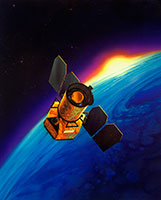
Optical
SDSS
The Sloan Digital Sky Survey (SDSS) is currently the deepest large-area optical survey that is publicly available. It makes use of a 2.5m wide-field altitude-azimuth telescope at Apache Point Observatory, New Mexico. The telescope has a 3deg field of view which is recorded by a large-format mosaic of 30 2048x2048 Tektronix CCD cameras in five filters (u, g, r, i and z-bands). The total survey is split into two main areas: the northern and southern Galactic cap. The northern Galactic cap is centered on α=12h20m, δ=+32.5deg, covers ~10,000 contiguous degree2 and was chosen to minimise the Galactic extinction. The southern Galactic cap is separated into three stripes, one centered on the celestial equator (α=20h07m,
δ=0deg), one north and one south of the equator.
The SDSS is an imaging and spectroscopic survey that is primarily focused on the identification and study of galaxies (e.g. Strauss et al. 2002) and quasars (e.g. Adelman-Mccarthy et al. 2006). The first public release of the SDSS was the Early Data Release in 2001 Stoughton et al. 2002). Technical details for which can be found in York et al. (2000). Further data releases and the corresponding information can be found in publications such as Abazajian et al. (2003, 04, 05) and Adelman-Mccarthy et al. (2006, 07, 08). Throughout the majority of this work, we have made use of the SDSS Data Release seven (DR7, Abazajian et al. 2009), which represents the final data release of the SDSS II project, including the low-latitude extension Sloan Extension for Galactic Understanding and Exploration (SEGUE; Yanny et al. 2009). SDSS DR7 provides ugriz photometry for 357 million objects, covering 11500 deg2, approximately one-quarter of the celestial sphere, as well as follow-up spectroscopy for 1.44 million galaxies, quasars, and stars. The SDSS is an ongoing operation which has been extended greatly since its conception. On top of the SDSS and SDSS-II discussed herein, SDSS-III has begun to be released, along with the BOSS, SEGUE-2, APOGEE and MARVELS sub-surveys.
The SDSS is observed in five optical photometric bands: u, g, r, i and z. The detection limits in 1" of seeing are 22.3, 23.3, 23.1, 22.3 and 20.8 mag respectively, on AB system, and assuming an airmass of 1.4. The filters have effective wavelengths of 3560, 4680, 6180, 7500 and 8870A. The photometric pipeline corrects for: CCD defects, calculated overscan, biases, sky, flat-field values and produces PSF magnitudes for all point sources. Mean errors are 0.03 mag at 20 mag, increasing to about 0.05 at 21 mag and to 0.12 at 22 mag for g, r and i-bands. For the less sensitive u and z-bands, errors increased to 0.05 at 20 mag and 0.12 at 21 mag.
The SDSS also provides a comprehensive follow-up spectroscopic program. Candidates for spectroscopy are chosen based on a series of cuts on their ugriz colours. The focus was primarily on providing spectroscopy of all the quasars in the SDSS footprint. The spectrograph covers 3800-9200A at λ/δλ from 1850 to 2200 depending on observation conditions. Each spectroscopic observation was taken using a custom made plate with holes drilled to allow the attachment of 640 fibres covering ~7 deg2. The holes were drilled at the positions of the SDSS photometry and then the spectroscopic fibres were plugged into the plate the day before the observations. A total of nine spectral plates were observed per night. Each are uniquely identified by their modified Julian date (MJD), spectroscopic plate and the fibre number. The total integration time for each spectra was 45-60 minutes, split into ~15 minute exposures. The flux and wavelength-calibrated spectra were provided on a vacuum wavelength scale and corrected to the heliocentric restframe.
Data access to the archive of SDSS survey is provided in three ways. Firstly, the Catalog Archive Server (CAS) contains the measured parameters for all the objects in the imaging and spectroscopic surveys. The SDSS Query Tool is a stand-alone application for providing queries to the CAS server. Secondly, the Data Archive Server (DAS) makes available all the raw
and reduced data (corrected frames, binned images, colour images, spectra). Finally, the SkyServer provides access to the data through a relational data base server using SQL.
An additional important resource within SDSS are proper motions. Data Release 7 incorporated substantial improvements in both the astrometric calibration, carried out against the UCAC2 catalogue (Zacharias et al. 2004), as well as an updated table of proper motions computed from the combined SDSS and USNO-B Monet et al. 2003-1 positions. Statistical astrometric errors per coordinate for bright stars were reduced to approximately 45 mas, with systematic errors of less than 20 mas.
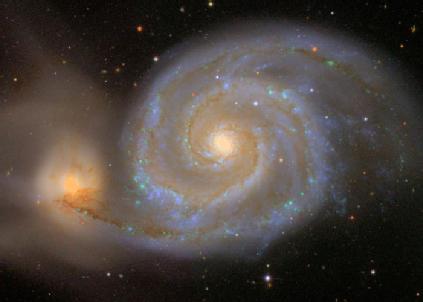
CMC
The Carlsberg Meridian Telescope (CMT) has a 2060x2048 CCD camera (pixel size 0.7") with a Sloan r filter operating in a drift scan mode. The CMT maps the sky from La Palma (Spain) covering the declination range -30 to +50deg with a magnitude range of rCMC=9-17. The Carlsberg Meridian Catalogue, Number 14 (Version 1.0; CMC) is an astrometric and photometric catalogue of 95.9 million stars with the aim to accurately transfer the Hipparcos/Tycho reference frame to Schmidt plates. The photometric catalogue, along with providing a Sloan r filter, is also cross-matched with 2MASS (within 2"; 2MASS is described in detail below) to provide some colour information. More information on both the telescope and the survey can be found in Evans (2001).

Near-Infrared
2MASS
The Two Micron All Sky Survey (2MASS; Skrutskie et al. 2006) is an uniform all-sky near-infrared survey designed to, amongst a host of other things, probe the large-scale structure of the Milky Way and the Local Universe and to search for rare, extremely red objects, such as brown dwarfs. 2MASS used two automated 1.3m telescopes, one at Mt. Hopkins, AZ and one at CTIO, Chile. Each was equipped with a three channel camera, each channel consisting of a 256x256 array of HgCdTe detectors, capable of observing the sky simultaneously at J, H and Ks (1.25, 1.65 and 2.17 μm). Each filter was observed for 7.8s such that a 1 mJy source would have a signal-to-noise ratio greater than 10 in each band. This corresponds to a 10σ point-source detection level of better than 15.8, 15.1 and 14.3 mag in the J, H and Ks-bands respectively. The 2MASS All-Sky Data Release includes 471 million sources in a Point Source Catalogue, and 1.6 million objects identified as being extended objects in the Extended Source Catalogue.
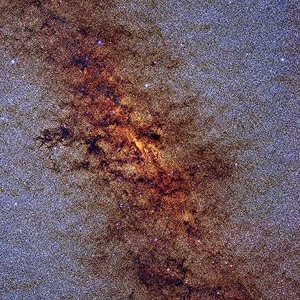
UKIDSS
The UKIRT Infrared Deep Sky Survey (UKIDSS; Hewett et al. 2006, Lawrence et al 2007) is a set of five near-infrared surveys being undertaken with the Wide Field Camera (WFCAM) instrument on the United Kingdom Infrared Telescope (UKIRT) in Hawaii. WFCAM has four 2048x2048 Rockwell devices imaging an exposed solid angle of 0.21deg2, which leads to a pixel scale of 0.4". UKIDSS began in May 2005 and will eventually survey 7500 deg2 of the Northern sky, entending over both high and low Galactic latitudes. It aims to become the successor to 2MASS, extending three magnitudes deeper in K. This project was designed to focus on the search for the coolest and nearest brown dwarfs, high-redshift dusty starburst galaxies, elliptical galaxies and galaxy clusters at redshifts 1‹z‹2, and the highest-redshift quasars, at z=7. The early data release was made public in 2006 (Dye et al. 2006) and subsequent releases continue to be made on six month or one year separations (e.g. Warren et al. 2007, Warren et al. 2007). One of the five sub-surveys, the Large Area Survey (LAS), aims to be the infrared counterpart to the SDSS. UKIDSS LAS will eventually provide imaging over 4028 deg2 in four broad band colours, Y, J, H, and K, with limiting (Vega) magnitudes of 20.2, 19.6, 18.8 and 18.2, respectively, which adds a significant increase in depth over 2MASS.
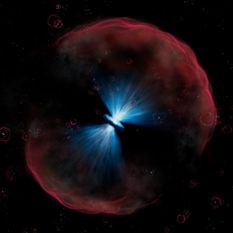
Mid-Infrared
WISE
The Wide-field Infrared Survey Explorer (WISE) is a NASA Medium-class Explorer mission designed to survey the entire sky in four infrared wavelengths, 3.4, 4.6, 12, and 22μm Wright et al. 2010). WISE consists of a 40 cm telescope that images all four bands simultaneously every 11 s. It covers nearly every part of the sky a minimum of eight times, ensuring high source reliability, with more coverage at the ecliptic poles. Astrometric errors are less than 0.5" with respect to 2MASS. The preliminary estimated S/N = 5 point source sensitivity on the ecliptic is 0.08, 0.1, 0.8, and 5 mJy in the four bands (assuming eight exposures per band; Wright et al. 2010). Sensitivity improves away from the ecliptic due to denser coverage and lower zodiacal background.
TELESCOPES
Infrared
Spitzer
The Spitzer Space Telescope (hereafter referred to as Spitzer) is the final mission in NASA's Great Observatories Program, observing the Universe in infrared light. Its companions in this program are the Hubble Space Telescope (HST), Compton Gamma-Ray Observatory (CGRO), and the Chandra X-Ray Observatory (CXO). Spitzer has a three instruments on board, namely the Infrared Array Camera (IRAC), the Infrared Spectrograph (IRS) and the Multiband Imaging Photometer (MIPS). Firstly, IRAC is an imaging camera designed to detect at near- and mid-infrared wavelengths. It takes simultaneous images at 3.6, 4.5, 5.8 and 8.0 microns, and each of the four detector arrays in the camera is 256x256 pixels in size. IRS provides both high- and low-resolution spectroscopy at mid-infrared wavelengths (from 5-40 microns). The detector arrays are 128x128 pixels in size. The instrument also has a Peak-Up Imaging (PUI) mode for performing photometry at 16 micron. Lastly, MIPS is a second imaging camera designed to perform at far-infrared wavelengths (24, 70 and 160 microns), however it also is capable of low-resolution spectroscopy. In 24 micron mode, MIPS uses an 128x128 pixels, however, at 70 and 160 micron an 32x32 and 2x20 pixel array are used respectively.
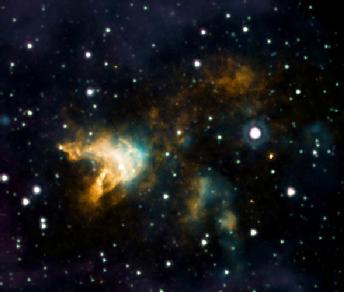
Write to:
Jonathan Girven,

